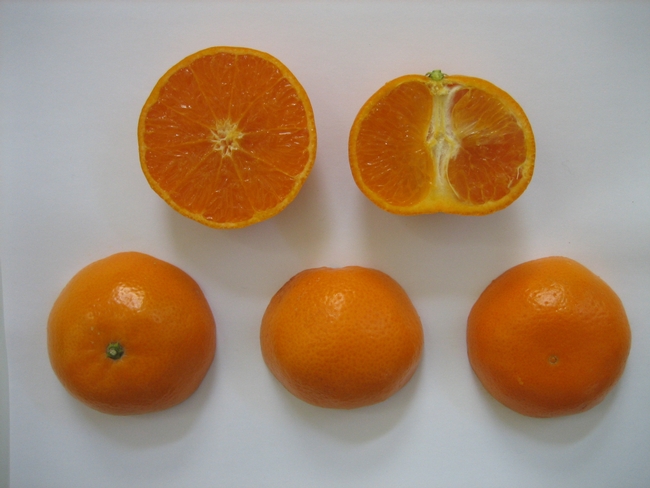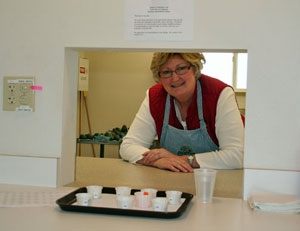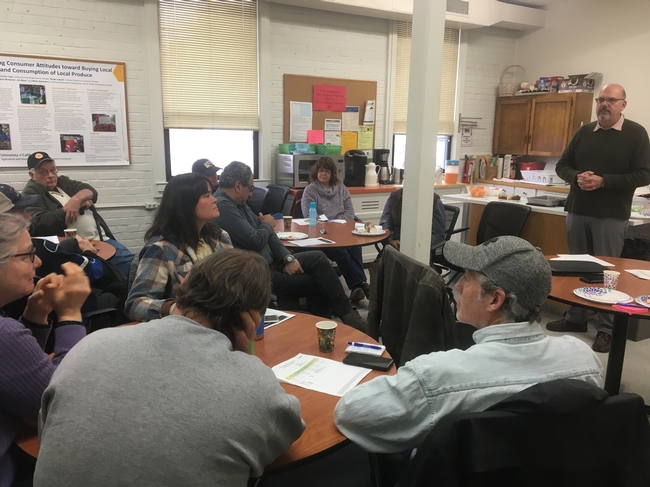
Posts Tagged: mandarins
Did You Miss the Farmer-to-Farmer Breakfast?
A room full of farmers came out on a rainy Wednesday morning to enjoy breakfast together. Our guest speaker, Domenic Fino of Golden Pacific Crop Insurance Services, came all the way from Dinuba, California. He is a farmer, with a family legacy of farming and has been in the crop insurance business for 17 years.
Revenue - While farm acreage and the number of zeros after the dollar sign may be smaller for local farms, revenue earned is revenue that can be lost and can be insured. Fino explained a type of insurance called Whole Farm Revenue Protection (WFRP) that was designed specifically for small to medium producers with diversified operations and unique specialty crops. WFRP has been around for the last five years but has only been available in Placer and Nevada Counties in the last two years. WFRP is currently available in all counties in all 50 states.
Records - Fino brought a wealth of experience and information to local producers. He helped explain that WFRP works only if the producer is able to keep proper records and has been reporting revenue on their taxes. “Garbage in, garbage out” Fino said, speaking of how important diligence in record-keeping and setting up the policy makes processing easier when there are claims.
Reporting - Whereas most types of insurance require claims to be made right after a loss, WFRP is unique in that a producer may only complete a claim after filing taxes for the year.
Restrictions – At the farmer-to-farmer breakfast, producers also learned of a few crops that are excluded from WFRP, mushrooms and timber. However, there is a program that can provide assistance for those products called Non-Insured Assistance Program (NAP) which is accessed through the Farm Service Agency. Several mandarin growers learned that while you must have at least two crops for WFRP with the second making at least 17% of your revenue, if you only sell mandarins, there is another option.
Single Crop Insurance - Mandarin only crop insurance is already available in six Southern California counties. Any mandarin farmer may request that type of crop insurance in their county. Once enough farmers request a single crop insurance in a county, it can create a bank of information that will eventually make that type of insurance written specifically for that county.
For more information about WFRP, visit the USDA Risk Management Agency website. https://www.rma.usda.gov/Fact-Sheets/National-Fact-Sheets/Whole-Farm-Revenue-Protection-2018
Did you miss this event? If you are interested in learning more about crop or whole farm revenue protection insurance, UCCE can provide information. Call 530.889.7385 or e-mail us, cefake@ucanr.edu or dmacon@ucanr.edu
Interested in attending a farmer-to-farmer breakfast? There is another one right around the corner. Wednesday, February 13, at Happy Apple Kitchen in Chicago Park. Look for a sign-up link coming soon.
UC studies cost of producing peppermint oil, almonds, walnuts, mandarins, winegrapes

Each analysis is based upon hypothetical farm operations using practices common in the region. Input and reviews were provided by UC Cooperative Extension farm advisors, UC researchers, growers, farm accountants, pest control advisers, consultants and other agricultural associates.
Each study describes the assumptions used to identify current costs for the individual crops, material inputs, cash and non-cash overhead. A ranging analysis table shows profits over a range of prices and yields. Other tables show the monthly cash costs, the costs and returns per acre, hourly equipment costs, and the whole farm annual equipment, investment and business overhead costs.
The new studies are as follows:
- Sample Costs to Establish an Orchard and Produce Almonds, 2012, Sacramento Valley, by Joseph H. Connell, William H. Krueger, Richard P. Buchner, Franz Niederholzer, Carolyn J. DeBuse, Karen M. Klonsky and Richard L. De Moura.
- Sample Costs to Establish a Walnut Orchard and Produce Walnuts, 2012, Sacramento Valley, by William H. Krueger, Richard P. Buchner, Janine K. Hasey, Joseph H. Connell, Carolyn DeBuse, Karen M. Klonsky and Richard L. De Moura.
- Sample Costs to Establish a Citrus Orchard and Produce Mandarins (Tango), 2011, San Joaquin Valley – South by Neil V. O’Connell, Craig E. Kallsen, Karen M. Klonsky, Richard L. De Moura and Kabir P. Tumber.
- Sample Costs to Establish a Vineyard and Produce Winegrapes (Cabernet Sauvignon), 2012, North Coast Region (Napa) by Monica L. Cooper, Karen M. Klonsky and Richard L. De Moura.
- Sample Costs to Establish a Peppermint Stand and Produce Peppermint Oil, 2011, Intermountain Region, by Rob Wilson, Daniel B. Marcum, Karen M. Klonsky and Richard L. De Moura.
All cost of production studies are available online at http://coststudies.ucdavis.edu, at UC Cooperative Extension offices or by calling (530) 752-3589. For more information about the studies, contact Richard De Moura at rdemoura@ucdavis.edu in the Department of Agricultural and Resource Economics at UC Davis.
It's a fruit...It's a mandarin...It's ‘KinnowLS’!
On the Jeopardy show, the clues could easily be: “It’s new and attractive. It’s juicy and sweet. And it’s low-seeded and peels easily.”
To which the answer would be, “What is ‘KinnowLS’?”
‘KinnowLS’ – the LS is short for low seeded – is the latest citrus variety released by researchers at the University of California, Riverside.
Large-sized for a mandarin, the fruit has an orange rind color. The rind is thin and extremely smooth. The 10-11 segments in each fruit are fleshy and deep orange in color.
‘KinnowLS’ matures during February through April, and does well in hot climates. It was developed by mutation breeding of the mandarin cultivar ‘Kinnow,’ a mid-to-late season maturing variety developed by UC Riverside nearly 100 years ago. While ‘Kinnow’ has 15-30 seeds per fruit, ‘KinnowLS’ has only 2-3 seeds per fruit.
“People who like very sweet fruit are going to find ‘KinnowLS’ to be very appealing,” says Mikeal Roose, a professor of genetics, who developed ‘KinnowLS’ along with staff scientist Timothy Williams. “When other citrus varieties mature to reach the level of sweetness of ‘KinnowLS,’ their other qualities – such as rind texture – are in decline. Neither ‘Kinnow’ nor ‘KinnowLS’ suffer in this way.”
Yet another attractive quality of ‘KinnowLS’ is that it can be grown in California’s desert regions because the fruit, which matures during February through April, does well in hot climates.
Indeed, ‘Kinnow’ is the most important mandarin in the Punjab regions of India and Pakistan, where ‘Kinnow’ fruit trees constitute about 80 percent of all citrus trees.
“But the fruit, which is popular there, is seedy,” Roose says. “Therefore, ‘KinnowLS’ has very good potential in this area of the world.”
Growers in India and Pakistan will have to wait a few years, however, before ‘KinnowLS’ trees can strike roots there. Currently, plans are to distribute ‘KinnowLS’ budwood, starting this month, to only licensed nurseries in California. (For three years, only California nurseries will be permitted to propagate ‘KinnowLS.’ Licenses for ‘KinnowLS’ propagation outside the United States will be issued thereafter.)
So when will we find ‘KinnowLS’ in U.S. produce aisles?
Alas, not for at least five years. It generally takes about that long to propagate citrus trees.

2602 1hi
Treat your mandarins right

“We think the flavor of mandarins declines much more rapidly than oranges,” said Sue Collin (right), a UC Riverside staff research associate who is based at the UC Kearney Agricultural Research and Extension Center in Parlier.
The way oranges are set out at the grocery store or on home counter tops could be trouble for the more delicate mandarin. And when mandarins make a six-week sea voyage to the Pacific Rim, will Asian consumers find the fruit acceptable?
In order to provide farmers, shippers and retailers accurate information about the impact of different storage temperatures on the quality of the fruit, Collin is working with UC Riverside sub-tropical horticulturalist Mary Lu Arpaia and USDA plant physiologist Dave Obenland to understand the changes in mandarins stored at a variety of temperatures, at different humidity levels, for various periods of time.
“A grocery store may be holding fruit at room temperature, 68 degrees or even warmer,” Collin said. “We’re comparing fruit that has been stored in very controlled atmospheres – at temperatures in the 40s, 50s and 60s.”
When it comes to understanding the acceptability of fresh fruit, nothing can match the human palette.
Collin recruits staff based at Kearney to take a break from their jobs to come to a laboratory built at the agricultural research station specifically for sensory testing. The 1,100-square-foot laboratory features neutral white paint and broad-spectrum lighting. The ventilation system was designed to minimize distracting odors. Inside, six tasting booths each have small windows that open to the kitchen area, where samples are prepared.
“We do quite a bit of testing to see if our volunteers can tell the difference in fruit stored at different temperatures,” Collin said.
In conjunction with the human testing, Obenland studies the fruit’s chemical composition to find out if objective numerical values correlate with the more subjective findings of the human tasters.
Although the optimal storage temperature for mandarins is still under investigation, Collin suggested consumers should keep their mandarins in the refrigerator at home for best results.
“I think the flavor holds better and the fruit lasts longer in the refrigerator,” Collin said.
This research is being funded in part by the Citrus Research Board.
Sensory Testing
Tango mandarins are soon to appear in a produce aisle near you
The first commercial crop of an exceptional new mandarin variety created by UC Riverside scientists will be harvested this month.
The fruit, called Tango, is the result of a mutation induced by irradiating budwood of W. Murcott mandarin. The process mimics nature’s manner of improving fruit. Radiation from the sun or natural errors during cell division can cause a single branch or fruit to mutate and develop unique characteristics, which scientists call a “sport.” People have been reproducing favorable sports for generations. In fact, all navel oranges are sports – natural mutations of oranges with seeds or other navel oranges.
W. Murcott mandarins, originally from Morocco, are favored for their deep orange color, easy-peel rind and tangy-sweet flavor. However, when planted within five miles of other seed-bearing citrus – such as Clementine mandarins, lemons or grapefruit – they can be cross-pollinated by bees and become seedy. The Tango maintains the best W. Murcott traits, but because it produces very little viable pollen, it is virtually seedless wherever it is grown.
“This is the most promising mandarin the university has ever produced,” said UC Riverside genetics professor Mikeal Roose.
The Tango mandarin was patented, and registered trees were established by the UC Citrus Clonal Protection Program. Distribution of budwood to citrus nurseries began in June 2006 and was limited exclusively to California growers for one year. Tango was introduced into Florida in 2007 and the trees were available internationally under exclusive licenses in 2009. Tango trees should soon be available to home gardeners through retail nurseries.
In all, 1.6 million Tango trees were sold in California through March 2010.
Tango is not a trademarked name, so the new seedless mandarin will probably be sold under existing grower brand names like Cuties and Delites. Before Christmas, fruit marketed as Cuties and Delites are early ripening Clementine mandarins. Most W. Murcotts and now Tangos will be sold as Cuties and Delites when they ripen in late January, but some Tangos will show up in supermarkets and farmer’s markets under the Tango name.
The Tango was made possible by a UC and citrus industry partnership going back nearly 15 years. Roose and staff research associate Tim Williams began field testing the fruit in 2001. The research and evaluation program was supported by the Citrus Research Board.
“What’s exciting is the parent variety of the Tango is a good piece of fruit,” said Ted Batkin, director of the Citrus Research Board. “It is without a doubt the most widely planted variety that we have released in the past 25 years.”

W. Murcott mandarin (left) and Tango (right).

